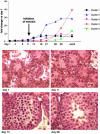A multitude of genes expressed solely in meiotic or postmeiotic spermatogenic cells offers a myriad of contraceptive targets
- PMID: 14526100
- PMCID: PMC218736
- DOI: 10.1073/pnas.1635054100
A multitude of genes expressed solely in meiotic or postmeiotic spermatogenic cells offers a myriad of contraceptive targets
Abstract
Understanding mammalian spermatozoan development and the events surrounding fertilization has grown slowly, in part because of uncertainty about the number and identity of the cellular components involved. Determination of those transcripts expressed specifically by germ cells should provide an inclusive list of probable critical proteins. Here, total mouse testis transcript profiles were trimmed of transcripts found in cultures enriched in Sertoli or interstitial cells to yield a germ cell-enriched transcript profile. Monitoring of changes of this profile in the developing testis identified 1,652 genes whose transcript abundance increased markedly coincident with the onset of meiosis. Remarkably, 351 of these genes (approximately equal to 20%) appear to be expressed only in the male germline. Germ cell-specific transcripts are much less common earlier in testis development. Further analysis of the UniGene EST database coupled with quantitative PCR indicates that approximately 4% of the mouse genome is dedicated to expression in postmeiotic male germ cells. Most or many of the protein products of these transcripts are probably retained in mature spermatozoa. Targeted disruption of 19 of these genes has indicated that a majority have roles critical for normal fertility. Thus, we find an astonishing number of genes expressed specifically by male germ cells late in development. This extensive group provides a plethora of potential targets for germ cell-directed contraception and a staggering number of candidate proteins that could be critical for fertilization.
Figures


Similar articles
-
Riding the spermatogenic wave: profiling gene expression within neonatal germ and sertoli cells during a synchronized initial wave of spermatogenesis in mice.Biol Reprod. 2014 May;90(5):108. doi: 10.1095/biolreprod.114.118034. Epub 2014 Apr 9. Biol Reprod. 2014. PMID: 24719255 Free PMC article.
-
Expression profiling of mammalian male meiosis and gametogenesis identifies novel candidate genes for roles in the regulation of fertility.Mol Biol Cell. 2004 Mar;15(3):1031-43. doi: 10.1091/mbc.e03-10-0762. Epub 2004 Jan 12. Mol Biol Cell. 2004. PMID: 14718556 Free PMC article.
-
The mouse X chromosome is enriched for multicopy testis genes showing postmeiotic expression.Nat Genet. 2008 Jun;40(6):794-9. doi: 10.1038/ng.126. Epub 2008 May 4. Nat Genet. 2008. PMID: 18454149 Free PMC article.
-
Toward understanding the core meiotic transcriptome in mammals and its implications for somatic cancer.Ann N Y Acad Sci. 2007 Dec;1120:1-15. doi: 10.1196/annals.1411.010. Epub 2007 Oct 2. Ann N Y Acad Sci. 2007. PMID: 17911412 Review.
-
Mammalian male germ cells are fertile ground for expression profiling of sexual reproduction.Reproduction. 2005 Jan;129(1):1-7. doi: 10.1530/rep.1.00408. Reproduction. 2005. PMID: 15615893 Review.
Cited by
-
Genome-wide differential expression of genes and small RNAs in testis of two different porcine breeds and at two different ages.Sci Rep. 2016 May 27;6:26852. doi: 10.1038/srep26852. Sci Rep. 2016. PMID: 27229484 Free PMC article.
-
Characterization of the promoter region of the murine Catsper2 gene.FEBS Open Bio. 2022 Dec;12(12):2236-2249. doi: 10.1002/2211-5463.13518. Epub 2022 Nov 17. FEBS Open Bio. 2022. PMID: 36345591 Free PMC article.
-
Testis-expressed protein 33 is not essential for spermiogenesis and fertility in mice.Mol Med Rep. 2021 May;23(5):317. doi: 10.3892/mmr.2021.11956. Epub 2021 Mar 24. Mol Med Rep. 2021. PMID: 33760102 Free PMC article.
-
Experimental validation of Ankrd17 and Anapc10, two novel meiotic genes predicted by computational models in mice.Biol Reprod. 2012 Apr 5;86(4):102. doi: 10.1095/biolreprod.111.095216. Print 2012 Apr. Biol Reprod. 2012. PMID: 22190705 Free PMC article.
-
Research resource: the dynamic transcriptional profile of sertoli cells during the progression of spermatogenesis.Mol Endocrinol. 2015 Apr;29(4):627-42. doi: 10.1210/me.2014-1356. Epub 2015 Feb 24. Mol Endocrinol. 2015. PMID: 25710594 Free PMC article.
References
-
- Lee, M. A., Kopf, G. S. & Storey, B. T. (1987) Biol. Reprod. 36, 617–627. - PubMed
-
- Eisenbach, M. (1999) Dev. Genet. 25, 87–94. - PubMed
-
- Garbers, D. & Quill, T. (2000) in The Testis: From Stem Cell to Sperm Function, ed. Goldberg, E. (Springer, New York), pp. 186–197.
-
- Wang, P. J., McCarrey, J. R., Yang, F. & Page, D. C. (2001) Nat. Genet. 27, 422–426. - PubMed
Publication types
MeSH terms
Substances
Grants and funding
LinkOut - more resources
Full Text Sources
Other Literature Sources
Molecular Biology Databases
Research Materials

